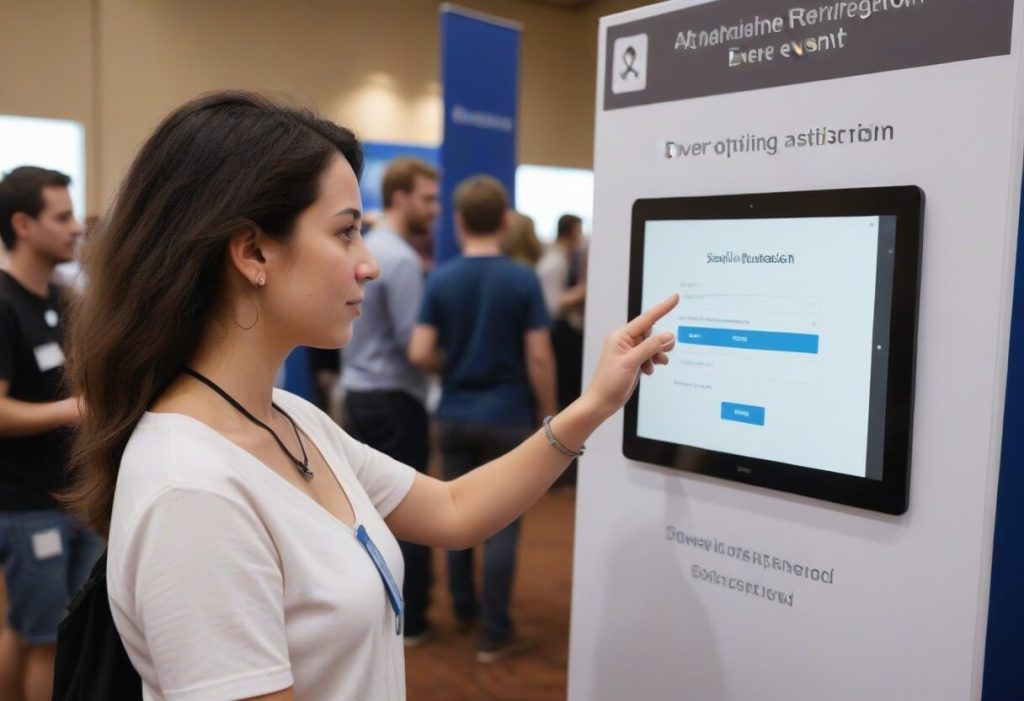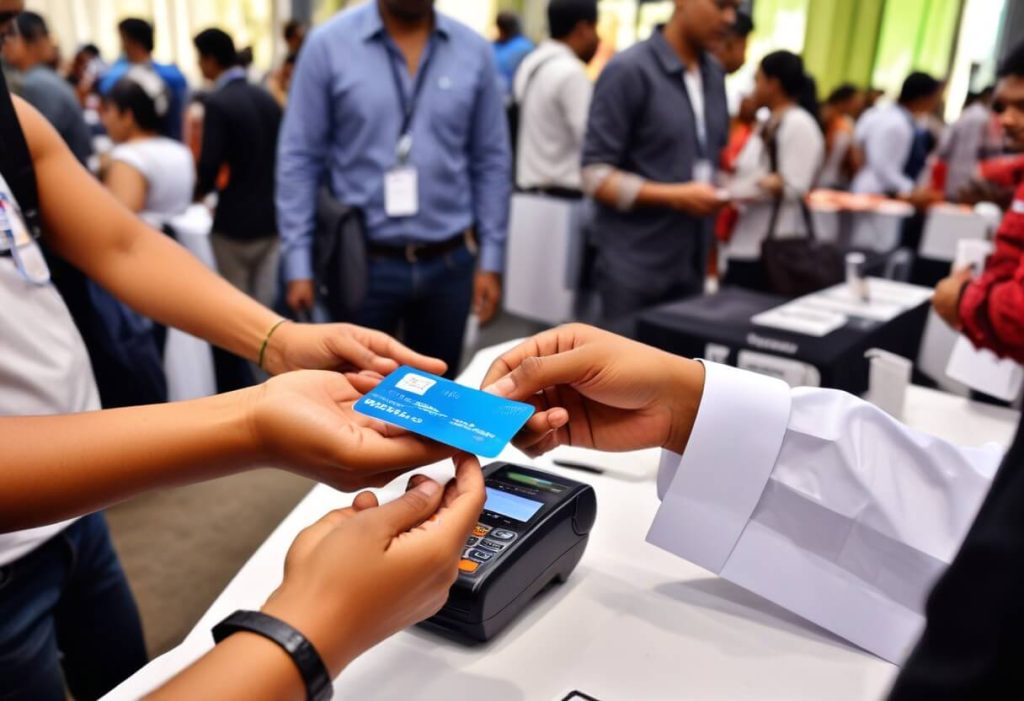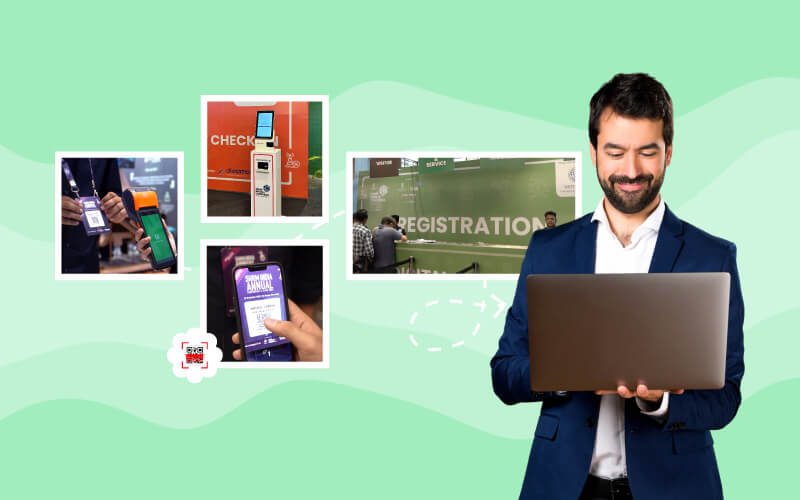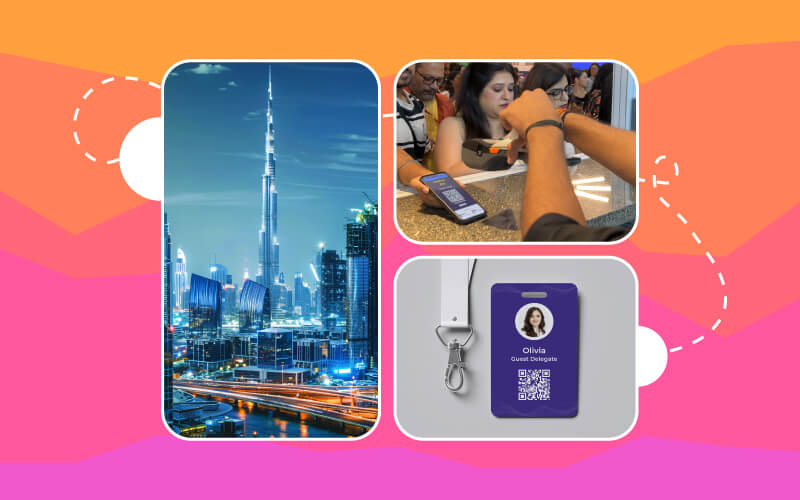Do you need help with event technical problems? No worries, we’ve got your back! We’ll be delving into the top 9 event technical problems that event organizers face. This blog offers actionable event technology tips to overcome them. No matter whether it’s check-in chaos to cash flow headaches or how to streamline entire event management from start to finish. Plus, we’ll explore and dish out insights on event production tech, security solutions, and post-event analytics. Ready to ace your event planning? Let’s dive in and tackle those tech hurdles together without any further ado!
Event Technology Issues: 9 Common and Frustrating Technical Problems
Let’s delve deeper into the technical problems at events and solutions outlined below:
1. Problem: Late Check-In and Long Lines
Explanation: Participants who arrive late or struggle with the registration process can lead to annoying bottlenecks and long lines. This leaves a bad first impression and delays the start of the event for those waiting in line.
Solution: Efficient Event Registration Methods:

- Online Pre-Registration: To avoid the hassle. Encourage attendees to register online via the mobile event app, online web portal or microsite in advance. However, this allows organizers to collect all the necessary information about attendees, further streamlining the onsite check-in process.
- Barcode Ticketing & QR Codes: Consider e-tickets over paper tickets, and provide attendees with barcodes or QR codes that can be easily scanned for quick check-in at events.
- Self-Service Kiosks: Implement self-service kiosks, so attendees may print credentials (event badges, QR codes etc) and complete any remaining registration processes, diminishing the need for manual check-in staff.
2. Problem: Cash Flow Issues and Manual Tracking
Explanation: Another event technology issues is handling financial transactions at a major event like trade shows, concerts, conferences etc., may be time-consuming, error-prone, and require extensive security precautions. Manually tracking sales may be stressful and susceptible to errors.
Solution: Introduce RFID Cards:

- Cashless System: Changing to an RFID framework offers various advantages. Participants buy an RFID-empowered wristband or identification during enrollment or on location.
- Secure Contactless Payments: This identification can then be utilized for contactless payments at food corners, stock merchants, and different retail locations all through the occasion. Transactions are secure and recorded electronically, taking out the requirement for cash dealing with and limiting blunders.
- Ongoing Sales Information: RFID innovation considers real-time sales information and other valuable data collection, giving important experiences into participant spending examples and seller execution.
3. Problem: Slow Badge Printing and On-site Delays
Explanation: Long queues for printing name badges can delay and disrupt participants’ access to the event. This is particularly frustrating when badges are required for access to certain areas or functions.
Solution: Utilize Self-Printing Kiosks:

- Reduced Queues: Conveying self-printing kiosks booths permits participants to abstain from sitting tight in line for identification printing.
- Expanded Efficiency: Participants can utilize their enrollment affirmation messages or QR codes to get to booths and print their customized identifications rapidly and effectively.
- Improved Flexibility: Booths can be decisively positioned all through the occasion space to limit blockage and guarantee participants can undoubtedly get to identification printing.
4. Problem: Limited Audience Reach and Engagement Beyond Physical Location
Explanation: Many people might be interested in an event but can’t attend due to geographical limitations or scheduling conflicts. This restricts the event’s reach and potential impact.
Solution: Embrace Live Streaming Services:
- Virtual Participation: Live streaming event sessions and presentations allows a wider audience to participate in real-time, even if they can’t attend physically.
- Increased Attendance: This expands the event’s reach, attracts a global audience, and opens doors for potential sponsors or partners seeking broader exposure.
- Engagement Opportunities: Consider incorporating live Q&A sessions or interactive elements during the live stream to keep remote audiences engaged.
5. Problem: Difficulty Creating a Personalized Attendee Experience
Explanation: Large events can feel impersonal, and attendees may struggle to find relevant information or connect with the right people. It’s another issue that event organizers have to deal with when it comes to event technology
Solution: Develop a Custom Mobile Event App:

- Personalized Experience: A custom mobile app provides attendees with a centralized hub for accessing event information, including schedules, speaker bios, event maps, and session descriptions.
- Networking Tools: Integrate features like attendee directories, chat functions, or appointment scheduling tools to facilitate networking and connections between attendees.
- Push Notifications: Send personalized push notifications based on attendee interests to highlight relevant sessions, networking opportunities, or special announcements.
6. Problem: Challenges with Contactless Check-In Methods
Explanation: New contactless check-in methods like facial recognition technology might encounter issues with accuracy due to lighting variations, facial expressions, or accessories like glasses. Additionally, privacy concerns need to be addressed.
Solution: Explore Facial Recognition Technology:
- Quick Check-In: For a streamlined event check-in solution facial recognition provides a safe and perhaps faster check-in option if compared to traditional manual or token ticketing methods.
- Improved Security: The technology can improve security by precisely confirming attendees’ identity.
- Transparency and Privacy: Ensure that attendees understand how face recognition data is gathered, kept, and used. Always emphasize data security, and provide guests the choice to opt out if they prefer conventional check-in methods.
7. Problem: Limited Data Insights and Event Analytics
Explanation: Without proper data collection and analysis, it’s difficult to understand attendee demographics, session engagement, or exhibitor booth activity. This lack of insights makes it challenging to improve future events.
Solution: Utilize Deep Data Analytics by Event Registration Platform:
- Data Collection: Many event registration platforms offer tools to collect valuable data on attendees, including demographics, session registrations, and exhibitor booth visits.
- Data Analysis and Insights: Use this data to gain insights into attendee behavior, session effectiveness, and exhibitor performance. These insights can be used to refine future events, improve content offerings, and optimize booth placement.
8. Problem: Low Technology Adoption and Engagement
Explanation: Attendees might not be comfortable or familiar with using new event technologies offered at the event, leading to one of the event technical problems. Also, it leads to missed opportunities for engagement and participation.
Solution: Incorporate AR/VR Gamification:
- Interactive Learning: Augmented Reality (AR) overlays can provide interactive information displays or scavenger hunt experiences within the event space.
- Immersive Experiences: Virtual Reality (VR) experiences can offer attendees a chance to virtually explore products or services showcased at the event.
- Gamification Elements: Incorporate game mechanics like points, badges, or leaderboards to incentivize technology adoption and encourage active participation in various event activities.
9. Problem: Low Post-Event Engagement and Feedback
Explanation: Without sufficient post-event engagement and feedback, it’s challenging to gauge attendee satisfaction and identify areas for improvement. This can hinder future event planning and lead to a disconnect with your audience.
Solution: Implement Strategies for Post-Event Engagement and Feedback:

- Post-Event Survey: Send out a concise and engaging survey shortly after the event to gather feedback on attendee experience, content quality, and overall satisfaction.
- Social Media Engagement: Continue the conversation post-event by sharing event highlights, speaker insights, and attendee testimonials on social media platforms.
- Networking Opportunities: Facilitate post-event networking opportunities through online communities or social events, allowing attendees to connect and build relationships beyond the physical event.
- Personalized Follow-Up Emails: Send personalized follow-up emails based on attendee interests. Share relevant resources, upcoming events, or special offers to maintain engagement and nurture connections.
By adopting these solutions, organizers can effectively address post-event challenges, gain valuable insights, and cultivate lasting relationships with attendees, setting the stage for future event success.
Conclusion:
Large events present many moving parts and potential hurdles. However, by understanding common technical problems and implementing proactive solutions, event organizers can create a smooth and successful experience for everyone involved. From streamlining registration processes to fostering post-event engagement, this toolkit equips you with the knowledge to overcome challenges and create truly memorable events.







